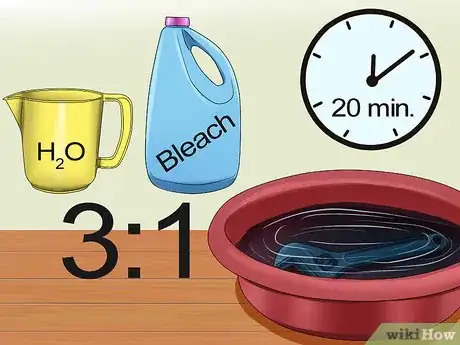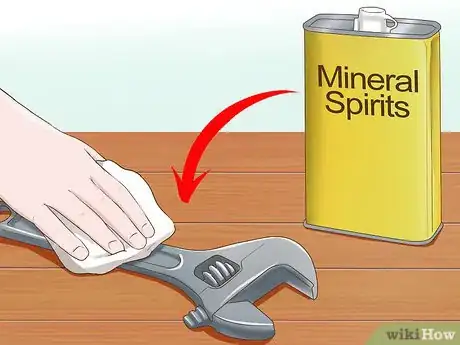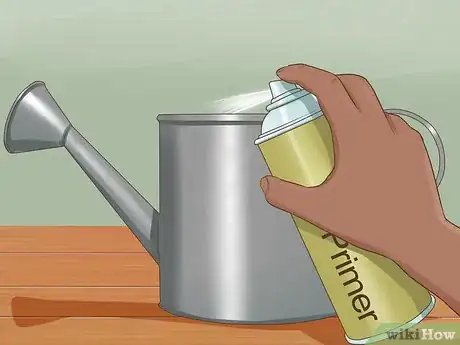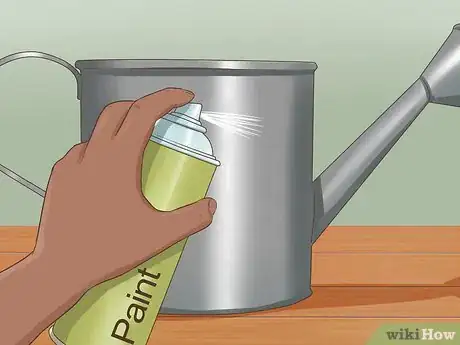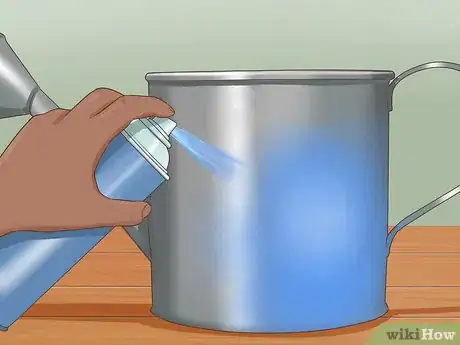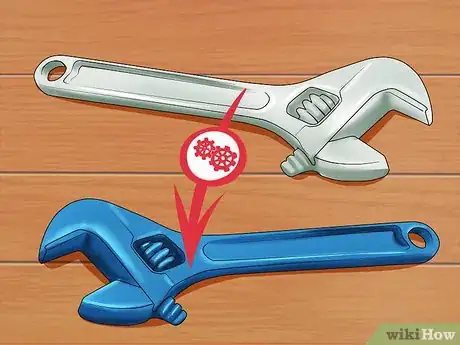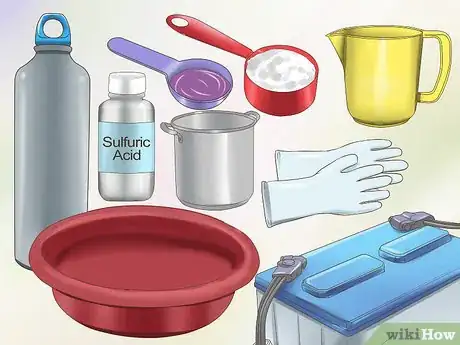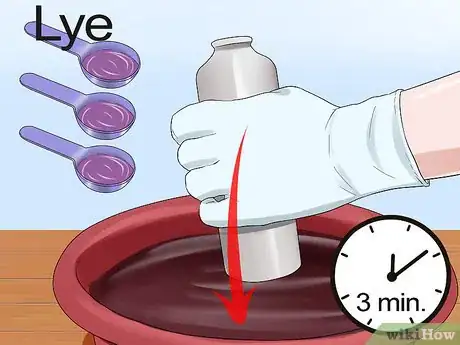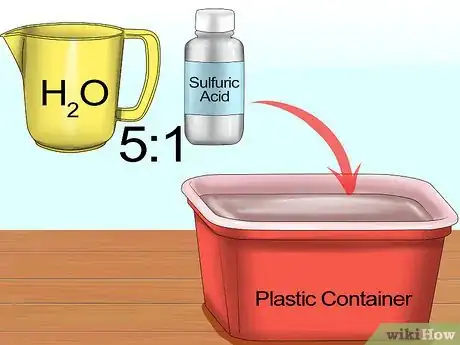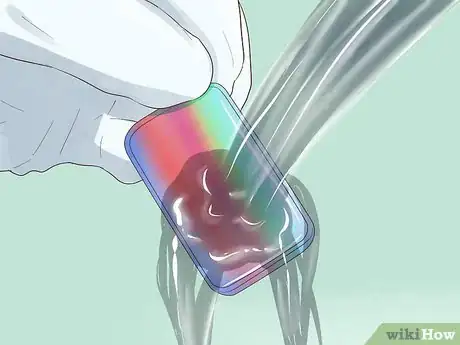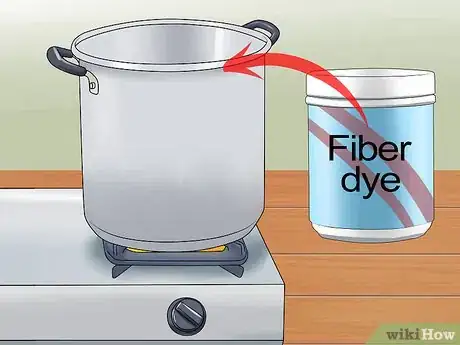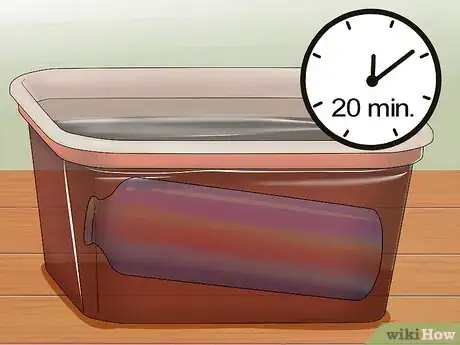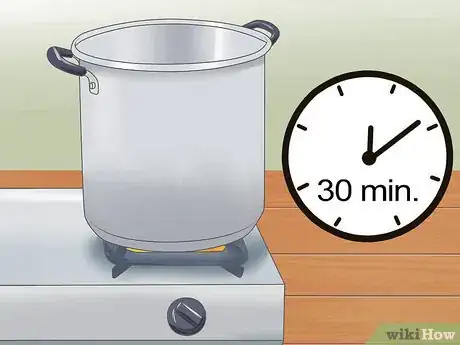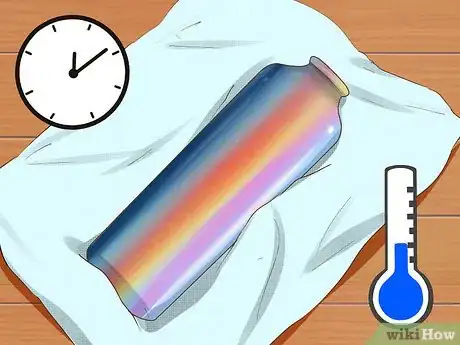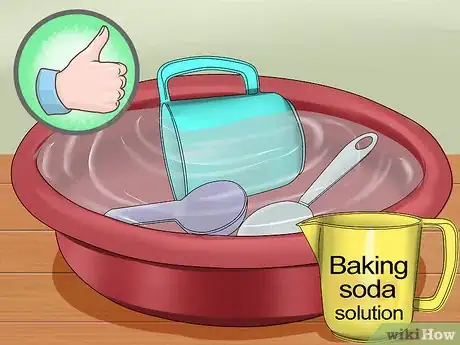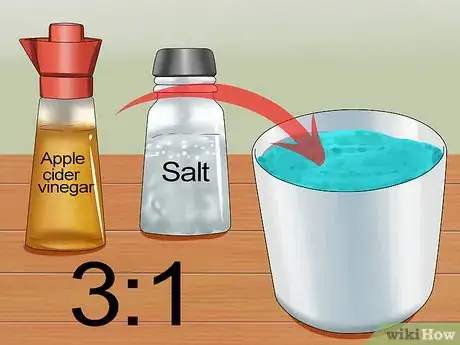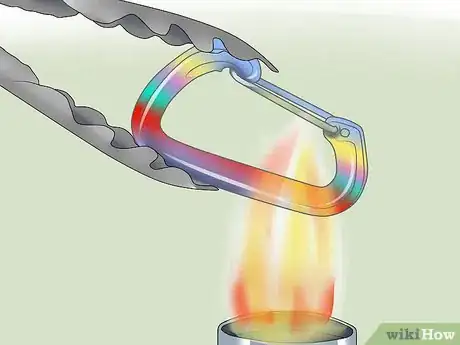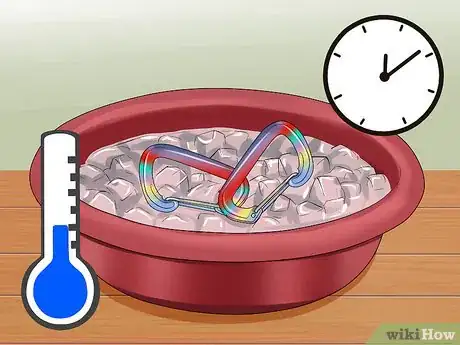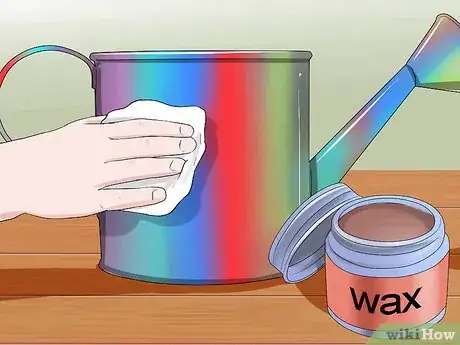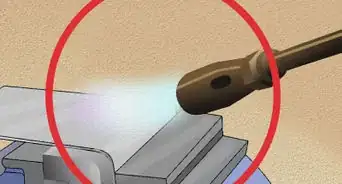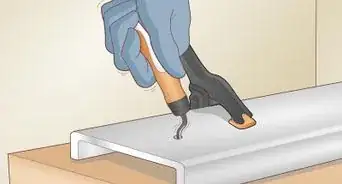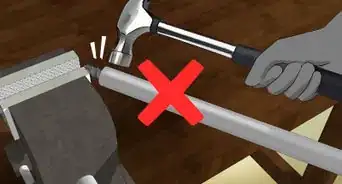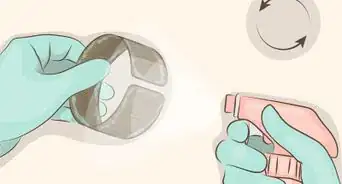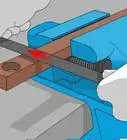This article was co-authored by Patrick Coye. Patrick Coye is the owner and operator of Patrick’s Painting & Home Improvement in Alexandria, Virginia. With over 15 years of experience in residential construction, Patrick specializes in painting, wallpaper removal/installation, drywall, staining decks and fences, and kitchen cabinetry painting. To date, Patrick and his team have painted over 2,000 houses and stained over 800 decks. Patrick's Company won a "Top Job" award from the American Painting contractor magazine in 2020.
There are 8 references cited in this article, which can be found at the bottom of the page.
This article has been viewed 264,603 times.
Coloring metal can be done by several different methods depending on the type of metal and the look you are hoping to achieve. You can make a piece look newer with a coat of fresh paint, create a vintage patina look, or change the color by anodizing the metal. The finish of your metal piece will go a long way towards determining the value, so choose a method that fits your project needs the best.
Steps
Spray Painting Metals
-
1Treat any mildew. Start by soaking the metal in bleach to kill the mildew and remove discoloration. Make a solution of water and bleach in a 3:1 ratio. Let the metal soak in the solution for approximately 20 minutes. Rinse your metal with plain water after you've finished. If the metal is new or free from any mildew, you can proceed without soaking the object in bleach.
-
2Remove any rust. Rough up the surface with a wire brush. You can also use an electric sander with coarse sandpaper, a power drill, or a rotary tool to remove all debris. Choose a grit between 36 and 100 to remove rust and smooth flaws.[1]
- Wear eye protection and a dust mask to avoid getting metal fragments in your eyes or lungs. Use a pair of work gloves to avoid injuries.
- For large objects, you can remove rust, debris, and old paint with a liquid commercial rust remover.
- Rubbing the surface with a wire brush also helps the paint adhere better to the metal.
Advertisement -
3Clean the metal object with mineral spirits. Mineral spirits are a type of turpentine-free paint thinner. Wipe the metal down with a rag dampened with mineral spirits. Remove any dust and debris that may be left behind from sanding. Make sure the surface is completely clean and dry so that the primer will stick to the object.
- Keep in mind that mineral spirits will strip any existing fresh paint.
- Also remember that mineral spirits will only strip away paint that is still fresh. If you want to remove existing paint that won't come off with mineral spirits, try cleaning your metal with turpentine instead.[2]
-
4Apply a coat of primer. Spray the primer on the surface in a smooth, even layer. You should coat the metal with primer as soon as the surface has been prepared to avoid dirt or rust accumulating on the surface again. Choose a primer specifically recommended for the type of metal you are painting.
- Choose a spray primer in the same color as the finish when possible.
- Try to purchase a primer in the same brand as the paint you will buy, as colors are more likely to be better matched and chemically compatible.
- Purchase primer that is rust resistant. For instance, oxidizing primer helps inhibit the growth of rust in the future.
- Priming with a paint brush is very difficult to do without leaving streaks. Use a spray primer for best results.
- Read the directions on the product to determine the necessary time for the primer to dry.
-
5Apply an even coat of paint. Be sure to shake the can first. Hold down the nozzle and coat the desired areas. Use masking tape or painter's tape to cover any areas you want to avoid painting. Hold the can approximately a foot away from the object. Start spraying off to the side of the object and move the can with a continuous motion across the metal object without pausing. Allow paint to dry.
- Control your environment. If you are painting a smaller object, you can place it in a cardboard box and apply your paint.
- If you pause while spraying, you may notice a splotch appear. Use a cloth to wipe away the wet paint immediately before it can dry. Allow the remaining paint to dry before starting again.
- Galvanized metals have a thin layer of zinc chromate. The biggest reason for paint chipping or not adhering to galvanized metal is that the paint bonds to the zinc coating, or the residue collected on the surface, rather than the metal itself. If you have a piece of galvanized metal, look for a paint that doesn't contain any alkyds,[3] as these oil-based binders can react with the zinc coating.
-
6Apply a second coat of paint. Once the first coat of paint has dried, you will want to apply a second coat of paint to the surface. Adding a second coat of paint will increase the life of your paint job. Allow the paint to dry.
- To get the best results, always wait 24 hours between applying coats of paint.[4]
Anodizing Metal
-
1Understand the anodizing process. Anodizing converts the surface of a metal object into its oxide form. Anodized aluminum oxide is incredibly tough and resistant to corrosion. It is also porous compared to unoxidized aluminum, allowing it to absorb a variety of metal dyes.
- The conversion process uses an electric current and a strong acid bath. The metal being anodized is connected to a circuit and placed in the acid bath where it acts as an anode (positive electrode). Negative hydroxide ions within the bath are attracted to the positive anode where they react with aluminum to form aluminum oxide.
- A scrap of aluminum is also placed in the bath, connected to the other wire. This serves as the cathode (negative electrode), completing the circuit.
- Aluminum is the typical metal of choice for this method, but other non-ferrous (non-iron) metals like magnesium and titanium can also be anodized.[5]
-
2Gather your materials. You will want to start by finding a space that you can work without causing any potential damage. You can gather these items individually, or you can purchase a commercial anodizing kit that should include everything you need.
- Select your metal. Any aluminum or aluminum alloy can be anodized. Other types of metal, like steel, won't work.
- You will need three plastic tubs. Each tub should be large enough to hold your metal object. One will be used for the cleaning process, one for the acid, and one for the dye bath. Large, plastic paint buckets will work well for most jobs.
- Get a plastic jug to hold your neutralizing solution.
- For reagents, you will need sulfuric acid, baking soda, lye, metal fiber dye, and distilled water.
- Find an adequate power source. You will want a power supply that is capable of producing a consistent flow of electricity up to a minimum of 20 volts. A car battery is ideal.
- Get two power cables to connect the car battery to the acid solution. They should be strong enough to use to grip and lift the metal object in and out of the solutions.
- You will also want a spare piece of aluminum to act as the cathode in the solution.
- Have a large pot and stove to boil the metal object.
- Always wear a pair of large rubber gloves. Since you are handling strong chemicals you will need to handle your materials safely to avoid contact with your skin at all times.
-
3Prepare a neutralizing solution. The neutralizing solution uses a baking soda base as an alkaline to neutralize the pH of the sulfuric acid. You should keep a neutralizing solution handy to neutralize sulfuric acid in an emergency and to clean equipment. If your skin should come in contact with the acid, always use the solution to neutralize the burn instead of making it worse with water.
- Add 2 cups (0.83 pt.) of baking soda to 1 gallon (3.79L) of distilled water.
-
4Prepare the metal. You can use any piece of aluminum alloy to anodize using this process. Put on a pair of rubber gloves before cleaning. Anything, even fingerprints, left on the surface can impact your results.
- Clean the parts with water and dishwashing detergent.
- Immerse the parts in a bath of water and lye. Add 3 tablespoons of lye for each gallon of water. Using your rubber gloves, lower the metal object into the solution for about 3 minutes.
- Rinse the object in distilled water. If the water does not bead, the aluminum is clean.
-
5Prepare the sulfuric acid solution. Add sulfuric acid to distilled water in a plastic container at a ratio of 5 parts water to 1 part acid.
- Do not use a container that is breakable like glass.
- Always add acid to water so the solution doesn't fizz. Adding water to acid can cause it to splash up out of the container.
-
6Set up the power source with positive and negative poles. With the power supply off, connect one cable to the positive output and the other cable to the negative.
- Connect the other end of the negative cable to the metal object and submerge it in a container of sulfuric acid solution.
- Connect the other end of the positive cable to a scrap piece of aluminum and submerge it into solution without touching the metal object.
- Turn on the power. The voltage you use will depend on the surface area of the metal you are using. Check the power supply. Start with a low voltage of about 2 amps, then increase the voltage up to 10-12 amps after a few minutes.
- Anodize aluminum for 60 minutes. Negatively charged aluminum will attract positively charged sulfuric acid. You will notice a lot of bubbles around the piece of scrap metal, but very little bubbling around the metal you are anodizing.
-
7Remove the metal piece and rinse thoroughly with water. Be careful not to let any acid drip off the piece. You may want to the hold the container containing your neutralizing solution beneath the metal as you move it to the sink. Hold the metal beneath the water for several minutes while rotating to clean each side thoroughly.
-
8Prepare the dye. Prepare a solution of fiber dye and distilled water in portions to reach the color you want in a separate container. Follow any manufacturer instructions for the particular dye you have purchased.
-
9Place the metal object into dye bath for up to 20 minutes. Depending on the desired color, you may only need to leave the metal in the bath for a minute or two. You can also gently heat the dye bath to help speed up the process. At first, you may have difficulty getting the precise color, so plan on trying out the process on a few practice pieces made of the same material first.
- The dye can be reused several times, so if you want you can store the dye in a plastic container after you've finished this dyeing session.
-
10Boil the object in water for 30 minutes to seal the color. Heat the water in a pot. Then immerse the object into the boiling water. The process will seal the dyes, but it will also cause them to fade slightly. This is another reason why it's a good idea to do at least one test piece first.
-
11Allow the object to cool. Remove the object from the hot water. Set it on a towel to cool for several minutes. Once the object is completely cool, the metal will be at its permanent new color.
-
12Clean all tools and containers with baking soda neutralizing solution. Rinse everything and be sure that none of the acid remains on anything that was in contact with it throughout the process.
Creating Patinas
-
1Create a patina mixture. There are many different recipes to create different patinas. Patinas change the color by creating a chemical reaction with the metal to create a colored film over the surface. You can use a patina on any copper or bronze metal to give the surface an aged color and appearance similar to the green coloring of the Statue of Liberty. Depending on the material, you can search for a patina recipe to create the color you are looking for or purchase one over the counter.
- For a green verdigris patina, add three parts apple cider vinegar to one part salt.
- For a black patina, add sulfur of liver (sulfurated potash) to warm water.
- Some patina recipes will require the metal to be heated before applying the patina, so you may need to purchase a torch to heat the metal.
-
2Fill a container with your patina mixture. You can use a regular paint bucket for cold mixtures, but you may want to use a large metal pot if the patina mixture needs to be heated. The bucket should be large enough to immerse your object in the solution. Patina mixtures may need to be heated or cooled, so use a container that will work for the temperature of your recipe.
- Some chemicals can give off hazardous fumes. Always use a workspace that is well-ventilated.
- If you are coloring an object that is too large to put in a container, you can put a patina solution into a spray bottle and spray it all over the metal. You can also wet a rag with the solution and rub it on the metal, or use a paint brush to apply it to the surface. Just be sure to wear rubber gloves when using harsh chemicals to avoid contact.
-
3Soak the piece in the mixture. Put on a pair of rubber gloves and place the metal object in the container filled with a patina mixture. Depending on your patina recipe, you may need to let the piece sit for anywhere from a few minutes up to several hours. Set a timer and wait.
-
4Remove the metal. Check on your piece after the allotted time. If you want a more intense color, let the metal soak longer. Put on a pair of rubber gloves and remove the metal once your metal has taken on its desired appearance.
-
5Let the metal dry completely. The patina will continue to change while the piece dries, so be patient. If you want to color the piece further, place it back into the mixture and repeat the process.
-
6Coat the metal with a varnish. Use a spray-on acrylic clear coat varnish to help protect the surface and coloration.
Coloring Metals with Heat
-
1Clean the metal. Remove all dust, dirt and fingerprints from the metal before beginning. Wash the metal with soap and water. Let the metal soak in a degreaser. Place it on a clean surface to dry.
- Do not handle the metal with your hands after cleaning. Even the grease from your fingers can impact the formation of the colors.
- Heat adds color to metals in a fairly unpredictable way that varies based on temperature, humidity, time, and the composition of the metal.[6]
-
2Turn on a heat source. You can use this method on any metals containing copper or iron, such as steel. A smaller, focused flame, such as a Bunsen burner or torch, will provide a more dramatic variation of colors. An open flame will create more of a subtle variation. Depending on the temperature that the metal reaches you can create a color from pale yellow to blue.[7]
- Use some tongs or a wrench or similar tool to grip the metal to avoid contacting the heated metal after exposing it to the flame.
- If you have an oven you can also heat the metal that way to provide a more even coloration.
-
3Expose the metal to the flame. There is not much you can do to control the pattern or formation of the coloration. You can only somewhat control the color by how long you heat the metal. You will notice that the piece doesn't remain the same color as it cools from the heat. For example, reds may cool to bluish purples.
- Be sure to heat metal only in a well-ventilated area.
- Use caution not to burn yourself. Wear some work gloves.
- If your flame is fine and your metal piece large enough, you can trace patterns onto your metal.
-
4Allow the metal to cool. Turn off the torch or heat source. Set the metal down somewhere safe, like a concrete floor, to cool. You may want to have a bucket of cold water on hand to dip the hot metal in and cool it quickly.
-
5Coat the metal with a varnish or wax. If you are working a piece of jewelry or art, you may want to apply a sealant to protect and give the metal a glossy finish. After the metal cools, apply a coat of beeswax or an acrylic clear coat to protect the colors and the surface.[8] Allow the finish to dry.
Community Q&A
-
QuestionWhere would I get sulfuric acid?
 Community AnswerYou can get it at any shop which sells chemicals. If not, you can buy it online.
Community AnswerYou can get it at any shop which sells chemicals. If not, you can buy it online. -
QuestionWill these steps work for metal rings?
 Community AnswerMost likely, but it depends on the type of metal.
Community AnswerMost likely, but it depends on the type of metal. -
QuestionWhat kind of paint should I use to color metal for figures?
 Community AnswerUse self-etching primer first, and then any paint you'd like! Enamels tend to be best on something outside that will see a lot of contact.
Community AnswerUse self-etching primer first, and then any paint you'd like! Enamels tend to be best on something outside that will see a lot of contact.
Warnings
- Working with sulfuric acid is high risk; follow safety instructions and have safety precautions and protocols in place.⧼thumbs_response⧽
- Be sure to use special safety equipment when handling all chemicals and sanding and painting.⧼thumbs_response⧽
Things You'll Need
Painting Metals
- Wire brush
- Semi-rough sandpaper
- Steel wool
- Mineral spirits or turpentine
- Drop cloth and rags
- Rust resistant spray primer and paint
- Safety equipment, including specialty gloves, safety goggles, proper mask
Anodizing Metals
- Source of current
- Sulfuric acid
- Metal fiber dye
- Aluminum scrap
- Two wires
- Lye
- Baking soda
- Distilled water
- Safety equipment
- Three sturdy containers, such as paint buckets
Creating Patinas
- Patina ingredients (will vary)
- Container
- Varnish
- Safety equipment
Coloring Metals with Heat
- Cleaning materials and degreaser
- Heat source
- Tongs
- Safety equipment
- Varnish
References
- ↑ https://www.lowes.com/n/buying-guide/sandpaper-buying-guide
- ↑ http://city.milwaukee.gov/AntiGraffiti/Graffiti-Removal-Techniques.htm#.VteNnPkrJaQ
- ↑ http://www.paintinfo.com/cn/cnp-006.shtml
- ↑ http://www.bobvila.com/articles/2293-paint-makeovers-an-expert-tells-all/#.VsHOscdh3dQ
- ↑ http://www.anodizing.org/?page=what_is_anodizing
- ↑ http://www.columbiamissourian.com/news/local/copper-tones/article_ad43e49b-3f4c-51c3-8fa5-3bf2306067a3.html
- ↑ http://www.technologystudent.com/equip1/heat1.htm
- ↑ https://www.craftsy.com/post/how-to-patina-copper/
About This Article
Coloring metal can be done by spray painting, anodizing the metal with metal dye, or creating a patina film. To spray paint metal, first soak your metal in bleach and water solution to kill any mildew and remove any discoloration. You can also remove any rust with a wire brush or clean it with mineral spirits, if needed. Once your metal is clean, spray a coat of primer in a smooth, even layer. When possible, pick a spray primer that’s the same color as the finish and is rust-resistant. After the primer dries, apply an even coat of paint, allow it to fully dry, then apply a second coat to increase the life of your paint job. To learn how to color metal by anodizing it, keep reading!
